|
Report from
Europe
UK tropical wood imports
recover ground despite
supply challenges
The UK imported tropical wood and wood furniture
products with a total value of US$290 million in Q1 2021,
a 2% increase compared to the previous quarter and 6% up
on Q1 2020 (even before the effects of the COVID
pandemic were being felt - Chart 1).

The strong performance in the first three months of this
year reflect both a robust rise in consumption in the UK,
supported by strong government stimulus measures, and
the late arrival of delayed shipments from the previous
year. The rise occurred despite severe logistical problems
that have emerged in shipment of tropical wood products
to the UK since the start of the pandemic.
After GDP in the UK fell 10% in 2020, the largest annual
decline for around 300 years, the latest economic figures
are much more encouraging.
In early May, the Bank of England (BOE) upgraded its
2021 growth outlook for the UK to 7.25%, up from 5% as
forecast in February.
The brighter economic forecast comes as the country
gradually emerges from lockdown and more people are
vaccinated against Covid. It follows a drop in first-quarter
UK GDP of 1.5% ¡ª shallower than expected at a time
when the country was again in lockdown ¡ª and as
restrictions on economic activity ease and Covid infections
in the U.K. continue to decline.
Reflecting on these developments, the BOE said secondquarter
GDP in the UK would likely ¡°rise sharply,¡± while
economic output was expected to recover to pre-pandemic
levels through the remainder of the year. It had previously
said the UK economy would recover to pre-pandemic
levels in the first quarter of next year.
The forecast of strong economic recovery is bolstered by a
very large fiscal stimulus. On 6 May, the BOE¡¯s Monetary
Policy Committee voted to hold interest rates steady at an
all-time low of 0.1% and maintain its quantitative easing
program at existing high levels (targeting asset purchases
of £895 billion, equivalent to US$1.2 trillion).
The UK construction sector, the leading driver of timber
demand in the country, has recovered particularly strongly.
According to the IHS Markit/CIPS UK Construction
Purchasing Managers Index (PMI), construction activity
has expanded in ten of the past eleven months, with
January 2021 the only exception.
UK construction companies signalled a strong increase in
output volumes in April, with continued recoveries seen in
civil engineering activity, commercial work and house
building. The PMI posted 61.6 in April, down only
fractionally from March's six-and-a-half year peak of 61.7
(any figure above 50.0 indicates an overall expansion of
construction output). Workloads in April were boosted by
the fastest rise in overall new construction orders since
September 2014.
Such is the strength of demand for construction materials
in the UK at a time when supply is extremely tight that
prices and delivery times are rising rapidly. The PMI
shows that the rate of increase in construction sector input
costs in April picked up for the seventh month in a row to
its highest level since the survey began in 1997.
The latest lengthening of suppliers' delivery times was also
the third-greatest since 1997, exceeded only by those seen
during the lockdown in April and May last year.
Construction firms mostly cited demand and supply
imbalances, but some suggested that Brexit issues had led
to delays in material arrivals from the EU.
UK wooden furniture imports from Singapore fill
supply gaps
Overall the UK imported USD170 million of tropical
wood furniture products in Q1 2021, the same level as the
previous quarter but 6% more than Q1 2020.
Compared to Q1 2020, imports were down from all three
of the leading tropical supply countries to this market;
Vietnam (-4% to USD80 million), Malaysia (-6% to
USD33 million) and Indonesia (-19% to USD11 million).
In contrast, imports from Singapore, at USD20 million,
were over three times larger than the same period last year
(Chart 2).
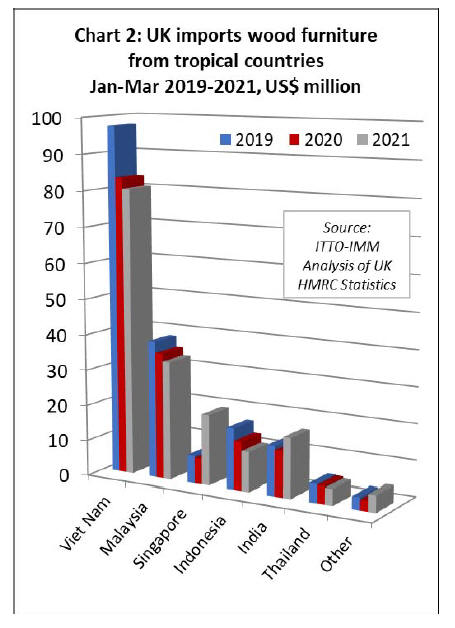
The size and direction of UK imports of tropical wood
furniture continue to be heavily influenced by lack of
freight space. The rise in imports from Singapore is due to
there being more container space available from Singapore
than elsewhere in South East Asia.
Although all countries worldwide have suffered from lack
of access to containers, the problem has been particularly
severe in the UK where ports have become severely
congested following the country¡¯s departure from the EU
single market at the start of this year.
The problem is so acute that shipping lines have been
trying to drive down demand from British importers by
charging a premium for deliveries to the UK or bypassing
the country's ports altogether. A recent report by the BBC
notes that one shipping line recently offered freight rates
of US$12,050 for a 40ft container from China to
Southampton but charged just US$8,450 for the same
container to travel from China to Rotterdam, Hamburg, or
Antwerp.
"Most of the carriers just don't want UK cargo because of
the issues when the vessels dock, so mainly they're
favouring European ports and we are having to truck
containers over," said freight forwarder Craig Poole,
quoted by the BBC. He said that adds a cost of up to
£2,000 per container and takes an extra seven to ten days
to reach the delivery point in the UK.
UK tropical wood imports rise 5% in first quarter 2021
UK imports of all tropical wood products in Chapter 44 of
the Harmonised System (HS) of product codes were
USD120 million in Q1 2021, 5% more than both the
previous quarter and Q1 2020.
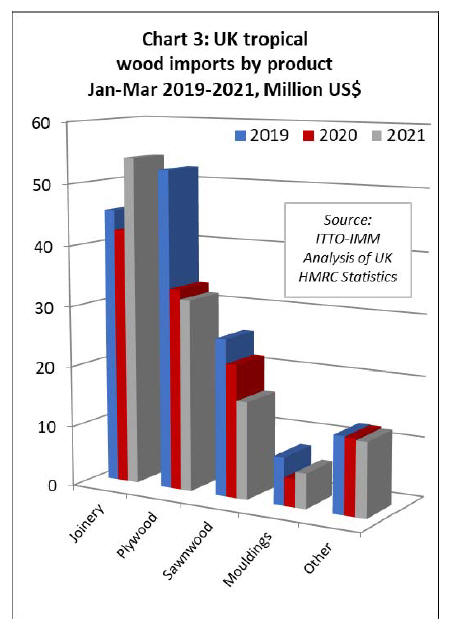
Compared to Q1 2020, UK imports of tropical joinery
products increased 28% to USD54 million while imports
of tropical mouldings/decking increased 24% to USD6
million. These gains offset a 5% decline in tropical
plywood imports, to USD32 million, and a 26% decline in
tropical sawnwood imports to USD16 million (Chart 3
above).
After the sharp dip in UK imports of tropical joinery
products during the first lockdown period in Q2 2020,
imports have progressively built momentum. Imports from
Indonesia, mainly consisting of doors, were USD31
million in Q1 2021, 20% more than the previous quarter
and a 33% gain compared to Q1 2020.
UK imports of joinery products from Malaysia and
Vietnam (mainly laminated products for kitchen and
window applications) also made strong gains in Q1 2021.
Imports from Malaysia were USD13 million in the three
month period, 16% more than the previous quarter and
13% up on Q1 2020. Imports of USD4 million from
Vietnam were 44% more than the previous quarter and
47% up on Q1 2020 (Chart 4).
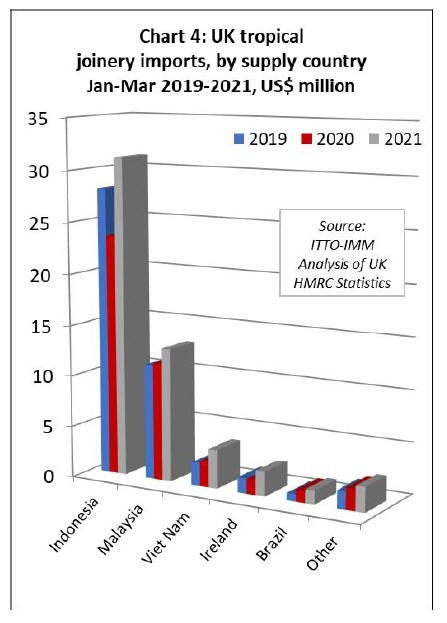
In Q1 2021, the UK imported 64,000 cu.m of tropical
hardwood plywood, 7% less than the previous quarter but
1% more than the same period in 2020. Imports from the
UK¡¯s three largest suppliers of tropical hardwood plywood
¨C China, Indonesia and Malaysia ¨C have followed very
different trajectories this year (Chart 5).
The UK imported 31,000 cu.m of tropical hardwood faced
plywood from China in Q1 2021, down 2% compared to
Q4 2020 but a gain of 23% compared to Q1 2020. Imports
from Indonesia also made gains in Q1 2021, rising 27%
against the previous quarter and 3% against the same
quarter in 2020 to 10,100 cu.m.
In contrast, imports of 11,800 cu.m from Malaysia in Q1
2021 were 27% down on Q4 2020 and 29% less than Q1
2020.
As with other hardwood product groups, UK demand for
tropical hardwood plywood has been strong this year,
driven by high levels of construction activity and
shortages of competing materials, and the main market
challenges have been on the supply side.
While Chinese hardwood plywood suppliers are reported
to have generally returned to pre-pandemic production
levels, some manufacturers in Indonesia and Malaysia are
reported to be still struggling.
¡°One of our leading Malaysian suppliers is still only at
50% of normal production due to safe distance work
practices and so many staff being in isolation,¡± said an
importer. The severe difficulties of obtaining freight space
and increased competition for supplies from buyers in the
US, where demand is also extremely strong, is adding to
UK supply difficulties out of Asia.
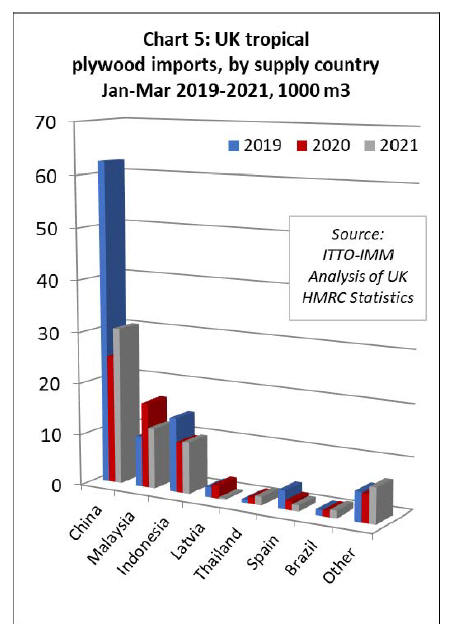
After falling sharply in May and June last year, UK
imports of tropical sawnwood strengthened between July
and December but the momentum slowed in the first
quarter of 2021. UK imports were 16,600 cu.m in Q1
2021, 31% less than the same period in 2020 and 20% less
than Q4 2020.
Imports from Cameroon continued to rise in Q1 2021, at
8,500 cu.m 3% more than Q4 2020 and 37% more than Q1
2020. Imports from Brazil were 1,200 cu.m in the first
quarter this year, 21% more than the previous quarter and
47% up on Q1 2020.
However, these gains were insufficient to offset a big
decline in UK imports of tropical sawnwood from
elsewhere. Imports from Malaysia were 1,200 cu.m in Q1
2021, 70% less than Q4 2020 and 71% less than Q1 2020.
Imports from Côte d'Ivoire were no more than 500 cu.m in
the first quarter of this year, 60% less than the same period
in 2020 and 33% down on the last quarter of 2020 (Chart
6).
Indirect UK imports of tropical sawnwood from other EU
countries also fell dramatically in the opening months of
this year, a sign of the immediate detrimental effects of the
UK¡¯s departure from the EU single market on 1st January.
Total UK imports from EU countries were 2,800 cu.m in
Q1 2021, 47% less than Q1 2020 and 40% down on Q4
2020.
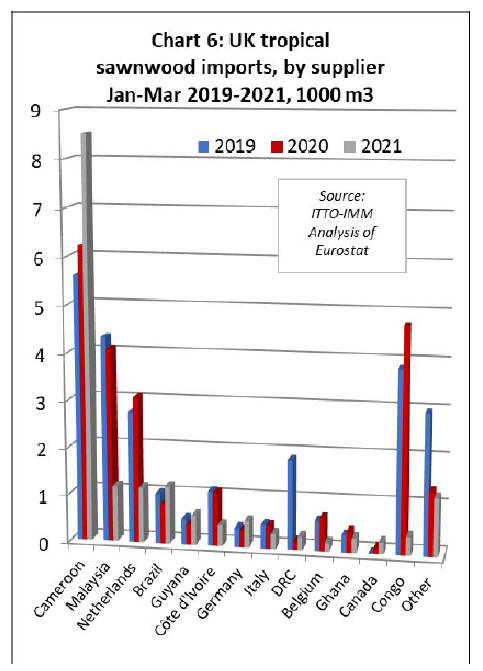
UK imports of tropical hardwood mouldings/decking
performed only marginally better than tropical sawnwood
in Q1 2021. Total imports of 1,800 tonnes were 7% up on
the previous quarter but 13% less than Q1 2020. Imports
of 500 cu.m from Indonesia were 36% less than Q1 2020
and 44% down on Q4 2020.
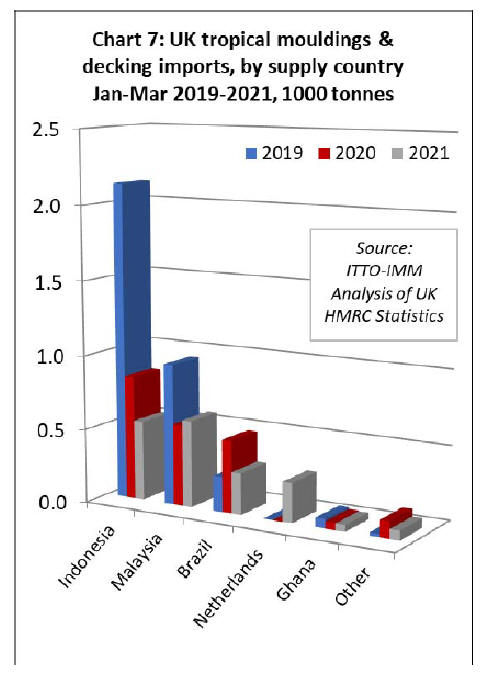
Imports of 300 cu.m from Brazil were 41% up on Q4 2020
but 43% down on Q1 2020. However these losses were
offset by a rise in imports from Malaysia which, at 600
cu.m were 46% more than Q4 2020 and 6% up on Q1
2020 (Chart 7 above).
Upward correction in African prices may be here to
stay
Market reports presented to the National Hardwood
Division of the UK Timber Trade Federation (TTF) on 12
May suggest that recent price increases for African sawn
hardwood may represent the ¡°correction that has been
expected for some time¡± and be here to stay.
The reports also highlighted that extreme shortages of
container space have led to the first breakbulk shipments
of Asian meranti and keruing lumber into the UK for
nearly 30 years, while the UK is also experiencing a
¡°massive shortage¡± in supply of Indonesian bangkirai
decking which has led to rising interest in Brazilian
hardwood alternatives.
The TTF report on the African hardwood trade noted that
relative to rapid and large price hikes for hardwoods
sourced from the US, the Far East and Europe since the
start of the pandemic, ¡°Africa, as is often the case, had
been slow to catch on and had not been subject to the same
levels of market volatility¡±.
The report goes on to note that ¡°lead times between
contracting and shipping product from this region is one
reason for this. Contracts placed back in 2020 are still
shipping and consequently the full reality of new price
levels are not yet being felt in the market place and may
not be for some time. But rest assured they are coming!¡±
The report highlights that global demand for species such
as Sapele, Sipo and Iroko, accompanied by production
delays and logistical difficulties, have been such that many
African mills placed a moratorium on taking new orders in
late March and throughout April this year.
¡°Placing new business now that will ship in 2021 is a
challenge and late shipments are leading to shortages in
some product in the market. The few mills with capacity to
take orders which can be produced and shipped relatively
quickly are taking advantage with high premiums being
requested¡±, according to the TTF report.
While African processors have been slower to respond
than elsewhere, ¡°over the course of the last couple of
months Africa is now starting to catch up. 10% increases
in shipping dry Sapele and Iroko have been felt within the
space of this period, which considering the previous 12
months saw a cumulative increase of roughly 5%, is a
steep jump. Sipo and other redwoods such as Khaya and
Tiama are replicating this trend¡±.
On other African species, the TTF report notes that
¡°Framire is proving increasingly challenging to source due
to a lack of raw material in the forest while even species
such as Ayous and Okoume are limited in supply.
This is in part due to the fact that consumer markets are
seeking new alternatives to their customary products such
as Poplar because of lack of supply¡±.
The TTF report stressed the severe impact of the pandemic
on hardwood production costs and volumes in Africa: ¡°it
is always a challenge in the region to maintain machinery
and obtain spare parts but with the logistical issues and
travel restrictions resulting from the Covid Pandemic, this
challenge has been exacerbated many times over.
Mills that have had breakdowns in key production
facilities such as kilns, head saws and boilers have simply
not been able to get the replacement parts or the
technicians to install them. The result of this is that many
mills are not running at anything like full capacity, and
this is unlikely to change for some time¡±.
The TTF report on Africa concludes by suggesting that
¡°while the global timber market is likely to see price
corrections in product from other source areas, the recent
increases in Africa may well be the correction that has
been in the making for some time. Less availability of
primary species in the forest, fewer producers to buy from,
increased costs and a growing global demand mean that
the price increases we have recently seen, and will
continue to see this year, are very likely here to stay¡±.
The TTF report on South East Asian hardwoods
highlighted that in the past 5-6 months there was a 4-5 fold
increase in container freights from the region which at one
stage (during Dec/Jan) virtually halted shipments of South
East Asian hardwood products to the UK.
Since Chinese New Year, with rates unchanged but
relatively stable, many buyers re-negotiated contracts with
their South East Asian suppliers to allow goods to be
shipped at the new freight rates.
The TTF report also notes that UK buyers of West
Malaysian meranti and keruing lumber and some finished
hardwood products recently took advantage of the first
breakbulk vessel to load hardwood for the UK in almost
30 years: ¡°that vessel is about 2 weeks off and we will see
how well [the UK port of] Tilbury handle what will be a
challenging range of timber products packaged in a form
the dock workers are not used to¡±. A second breakbulk
vessel destined for the UK is expected to be loaded in
Malaysia during June.
According to the TTF report, freight costs of the breakbulk
shipments from Malaysia to the UK are about
USD150/170 per cu.m compared to container rates
currently anywhere between USD280/cu.m and USD
460/cu.m depending on where the goods are loading and
what volume can be loaded in a container.
The TTF report notes that ¡°many buyers are buying
Meranti and Keruing Lumber on a forward basis and we
have seen FOB prices rising, but nothing like the increases
we have seen from other supplying regions. It is very
likely that DRM [dark red meranti] and keruing volumes
will (during 2021) be the same or less than last year.
This is in part due to Covid but also due to the Federal
Government placing volume extraction restrictions, so
time will tell if there is sufficient lumber coming onto the
market in the summer¡±.
The TTF report also highlights the severe lack of bangkirai
decking in the UK market which was ¡°initially due to the
freight hikes at the beginning of the year but, it seems, in
the past 3 months or so, due to suppliers selling UK bound
stocks to other markets at a time when the availability of
(replacement) logs and lumber suddenly dried up¡±.
The number of Indonesian mills offering bangkirai for sale
to UK importers is now very restricted and the few offers
being made are ¡°at prices about 50% higher than where
they were back in December which has led to significant
interest in cheaper Brazilian Decking species¡±, according
to the TTF report.
TTF ramps up communication on benefits of tropical
timber
The UK TTF is ramping up a communications campaign
which aims to enhance customer and specifiers awareness
to the benefits of FLEGT-licensed tropical timber as a
safe, legal, and responsible method of timber use ahead of
the rescheduled COP26 UN Climate Change Conference
now due to be held in the UK in November.
It has launched ¡°Conversations about Climate Change¡±, a
design competition, exhibition, and event series,
showcasing thought-provoking designs using responsibly
sourced tropical timber.
The virtual exhibition can be accessed online at:
(https://www.buildingcentre.co.uk/whats_on/conversationsabout-climate-change-the-virtual-exhibition).
According to the TTF, their FLEGT project ¡°works to
tackle stereotypes around tropical timber, educating
audiences on the benefits of specifying and including
FLEGT in procurement policies as a holistic approach to
responsible, sustainable timber¡±.
The TTF notes that engaging with designers, architects,
and craftspeople on the benefits of FLEGT-licensing has
been really well received. ¡°When it comes to
communicating complex conversations, we took the
approach that the best mechanism is to start designing with
it ¨C to showcase the beauty and unique properties of
tropical hardwoods, the encompassing benefits to
countries engaging in FLEGT, and to trace the story back
from there¡±.
With further Foreign Commonwealth & Development
Office (FCDO) government funding, the TTF FLEGT
Project is planning a further design initiative, with an
exhibition to coincide with COP26 in November,
promoting FLEGT and highlighting the environmental
significance of forests and timber.
The TTF has also begun plans for the construction of a
timber pavilion at COP26 and the creation of a wider
communication programme with other FCDO grantees and
is seeking to ¡°bring together all willing VPA FLEGT
countries to develop a joint tropical timber manifesto and
agenda¡±. This will focus on ¡°FLEGT and tropical
hardwoods and will include advocacy of zero tariffs for
FLEGT-licensed products¡±.
TTF aims to continue FLEGT communications after
COP26 to ¡°ensure changes initiated remain on the climate
agenda, with enhanced promotion of FLEGT to specifiers
in Europe and the UK. Further educational work includes
additional e-learning modules for national associations on
FLEGT, sustainable forest management and timber
legality/sustainability¡±.
To find out more email: lbedry@ttf.co.uk
|